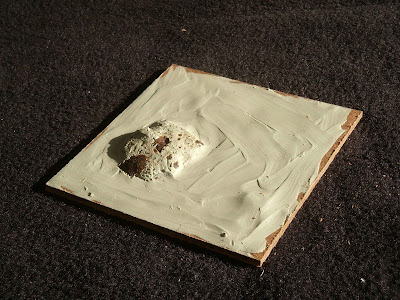Even after a river has been channelized, it finds a subtle version of its original meander. In other words, it finds the essence of its own movement. This film draws a satirical parallel from the river channel to the pedestrian crosswalk.
Sunday, June 19, 2011
1-minute film
The project was to make a one minute film that commented on my everyday relationship to the landscape. I chose what I consider the most mundane: the crosswalk. While pondering the crosswalk, I began to see all of the channels, or lanes, in which we have compartmentalized the everyday flows of life. Our rivers flow in channels, our vehicles flow within lane lines, our pedestrians walk on sidewalks, and our cyclists are squeezed in between. Other invisible channels include, but are not limited to, our sewer and storm water lines, gas, and energy lines, all of which are only vaguely threaded into the consciousness of everyday life.
Even after a river has been channelized, it finds a subtle version of its original meander. In other words, it finds the essence of its own movement. This film draws a satirical parallel from the river channel to the pedestrian crosswalk.
Even after a river has been channelized, it finds a subtle version of its original meander. In other words, it finds the essence of its own movement. This film draws a satirical parallel from the river channel to the pedestrian crosswalk.
Thursday, February 24, 2011
Metal Islands
This summer as I canoed the Providence River, I discovered the evidence of its industrial past through the scrap metal that littered the river bottom. This first image imagines the scrap metal collected and welded into mounds, partially filled with soil, but allowed to experience the endless cycle of accumulation and revelation, sculpted by seasonal wind patterns. The Providence River, though relatively shallow, is a brackish tidal river with tides fluctuating six feet daily. The breathing of the tides will constantly change the nature of these islands through deposition of soil, erosion, and the support of various river ecosystems. The edge condition allows the occupant different relationships with the islands through the changing of levels, and therefore, perspective views. The islands remain tangibly inaccessible, inciting the viewer's curiosity as they continually register time.
 | ||
| Site Plan: 1:80 |
 |
| Topographic Plan: 1:40 |
 |
| Section: mixed media, 1:10 |
 |
| Section: mixed media, 1/4"=1' |
 |
| Detail model: chip board, copper, 1/4"=1' |
 |
| Site model: clay, wax, copper, sand, 1:20 |
Exploration of the Ephemeral
Constructed Ground studio focused on land form with minimal program. The Providence River, site of my intervention, runs through the affluent downtown and into more derelict neighborhoods beyond. In my first experience of the site, I was particularly struck by an abandoned pier situated beneath the
Point Street Bridge. This island of ruins excited a curiosity rooted in a desire to understand the past and its relationship to the present. The marks that we make never really go away, rather they evolve through us, take on new meanings, shape the way we think, the things we make, and our relationship to our spaces and environments. These artifacts from the past invoke something
powerful, something mysterious. The following images are sculptural gestures investigating this ephemeral quality reflected through the presence of the piers, the last of which became the impetus for my final design.
Point Street Bridge. This island of ruins excited a curiosity rooted in a desire to understand the past and its relationship to the present. The marks that we make never really go away, rather they evolve through us, take on new meanings, shape the way we think, the things we make, and our relationship to our spaces and environments. These artifacts from the past invoke something
powerful, something mysterious. The following images are sculptural gestures investigating this ephemeral quality reflected through the presence of the piers, the last of which became the impetus for my final design.
 |
| Embossing on watercolor paper, charcoal |
 |
| Plaster and cheesecloth |
 |
| Plaster |
 |
| Plaster, metal screen, cheesecloth |
 |
| Plaster, metal screen, cheesecloth |
 |
| Clay and metal screen |
 |
| Clay and rusted metal |
Tuesday, February 22, 2011
From Knot to Structure
Design Principles studio began with a piece of rope and directions on how to tie a knot. The butterfly knot, considered one of the strongest knots, can be pulled in 3 directions without distortion. By studying the logic of the knot, its structural
stability, and its geometries, I developed a series of related projects. The first project was to create a unit with the ability to aggregate into a massing. The second project required a relationship to ground, and the third, an understanding of scale and enclosure. The final structure, a series of terraces that step down with the existing landscape, control views out
to sea.
 |
| Graphite on vellum |
 | |||||
 |
| Graphite and charcoal on vellum |
 |
| Paper and Cardboard |
 |
| Graphite and charcoal on vellum |
 |
| Chip board and Cardboard |

 |
| Graphite and watercolor marker on vellum |
 |
| Butter board, cardboard, plexi-glass |
 |
| Perspective: Graphite on vellum |
 |
| Sections: Graphite and colored pencil on vellum |
Sunday, February 20, 2011
Translating Fluidity
This project was a 4-week intensive studio to kick off my 3 years at Rhode Island School of Design in August 2010. I began by making charcoal drawings of the Providence River, which I then translated into a topographic map. The map developed through a system I imposed relating elevation changes to the values represented in the drawing. The subsequent models then aimed to express the invented landscape in different ways.


Subscribe to:
Posts (Atom)














